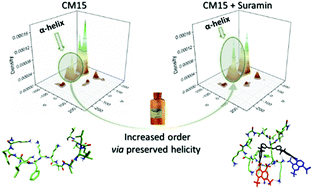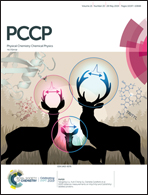The molecular mechanism of structural changes in the antimicrobial peptide CM15 upon complex formation with drug molecule suramin: a computational analysis†
Abstract
Dynamic increase of resistant bacterial infectious diseases continuously requires development of novel compounds against them. The molecular level understanding of the mechanism and interactions of natural host-defense peptides or antimicrobial peptides (AMPs) is an important step towards rational design and development of compounds inspired by their function. A particular set of these peptides have disordered structure, the ordering of which may modify their antimicrobial properties. Recent experiments demonstrate that such conformational transitions of AMPs could be mediated by the presence of small organic compounds, such as approved drug molecules. However, the molecular mechanisms underlying these structural changes are unclear. In this study, we apply molecular docking and molecular dynamics-based approaches to rigorously analyze the interactions between the drug suramin and the AMP CM15, a synthetic unstructured hybrid peptide. We characterize the energetic properties of putative CM15–suramin complexes revealing particular impacts of CM15 residues as well as the parts of suramin on these interactions. We find that α-helical content of the peptide is increased in the presence of suramin, which is in agreement with the experimental data. Kinetics analysis from canonical molecular dynamics and metadynamics simulations suggest that the effect of suramin does not promote the formation of α-helix but rather results from its ability to stabilize the α-helical population in the conformational pool of the peptide. Potentially, understanding the physico-chemical basis underlying the interactions between drug molecules and disordered AMPs will prove useful in strategies for antimicrobial compound development. Further on, the given computational protocol for the analysis of such flexible systems provide a basis for future theoretical investigation of similar biomolecular complexes.



 Please wait while we load your content...
Please wait while we load your content...